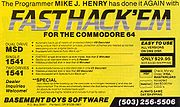
Fast Hack'em
Encyclopedia

Commodore 64
The Commodore 64 is an 8-bit home computer introduced by Commodore International in January 1982.Volume production started in the spring of 1982, with machines being released on to the market in August at a price of US$595...
nibbler
Bit nibbler
A Bit nibbler, or nibbler, is a computer program that defeats some software copy protection schemes by reading a floppy disk one bit at a time, and directly interacting with the disk drive hardware.- References :* *...
and disk editor
Disk editor
A disk editor is a computer program that allows its user to read, edit, and write raw data on disk drives ; as such, they are sometimes called sector editors, since the read/write routines built into the electronics of most disk drives require to read/write data in...
written by Mike J. Henry and released in 1985. It was distributed in the U.S.
United States
The United States of America is a federal constitutional republic comprising fifty states and a federal district...
via Henry's "Basement Boys Software", and in the U.K.
United Kingdom
The United Kingdom of Great Britain and Northern IrelandIn the United Kingdom and Dependencies, other languages have been officially recognised as legitimate autochthonous languages under the European Charter for Regional or Minority Languages...
via Datel Electronics
Datel
Datel is a UK-based electronics and game console peripherals manufacturer. The company is best known for producing a wide range of hardware and peripherals for home computers in the 1980s, for example replacement keyboards for the ZX Spectrum, the PlusD disk interface and the Action Replay series...
. http://commodore-gg.hobby.nl/hkessels/boeken/picture/engels/e-64-178k.jpg In the U.S., it retailed for $29.95.
Features
The most popular feature of Fast Hack'em was its ability to produce copies of copy-protectedCopy protection
Copy protection, also known as content protection, copy obstruction, copy prevention and copy restriction, refer to techniques used for preventing the reproduction of software, films, music, and other media, usually for copyright reasons.- Terminology :Media corporations have always used the term...
commercial software. When using the nibbler, disk copying was done on a very low level, bit-by-bit rather than using standard Commodore DOS
Commodore DOS
Commodore DOS, aka CBM DOS, was the disk operating system used with Commodore's 8-bit computers. Unlike most other DOS systems before or since—which are booted from disk into the main computer's own RAM at startup, and executed there—CBM DOS was executed internally in the drive: the DOS...
commands. This effectively nullified the efficacy of deliberate disk errors, non-standard track layouts, and related forms of copy prevention. Copying a protected disk took approximately 60 seconds if being copied directly to another disk drive, or 3 minutes (plus several disk swaps) if performed using a single disk drive.
Fast Hack'em also included a superfast disk copier that could copy unprotected disks at even higher speeds. Only 35 seconds were required for a direct drive-to-drive copy, or 2 minutes plus swapping time for a single-drive copy.
For all forms of copying, Fast Hack'em could verify the resulting disk copies to ensure that they were valid.
Fast Hack'em was updated quite often, and later versions added even more copying options. The one feature that stood out from other copying programs was that these updates included "parameters". They included the methods of copy protection individual programs used so even a fast copy could then be artificially "re-protected" and give a working copy.
In later versions of Fast Hack'em, disk copying could be performed without the computer if two Commodore 1541 disk drives were available. The software would be loaded with a Commodore 64, the two drive option would be selected which transferred software to the drives' controller memory, the serial cable could be disconnected from the computer. Any number of copies could be performed as long as neither drive was powered down.

